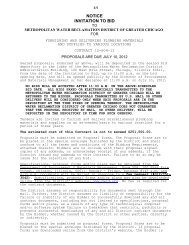Report - Metropolitan Water Reclamation District of Greater Chicago
Report - Metropolitan Water Reclamation District of Greater Chicago
Report - Metropolitan Water Reclamation District of Greater Chicago
You also want an ePaper? Increase the reach of your titles
YUMPU automatically turns print PDFs into web optimized ePapers that Google loves.
iosolids users under the <strong>District</strong>'s Controlled Solids Distribution Program. Biosolids marketing<br />
activities include preparation <strong>of</strong> promotional documents, showcasing the <strong>District</strong>'s biosolids<br />
management program at local trade shows and conferences, and presentations to potential<br />
biosolids users. In 2010, the Section conducted one exhibition and one field day to promote<br />
beneficial use <strong>of</strong> the <strong>District</strong>'s biosolids. During the year, biosolids and technical support were<br />
provided to a total <strong>of</strong> 43 users consisting <strong>of</strong> 17 new and 26 returning users. These users include,<br />
park districts, villages, golf courses, landscapers, and schools.<br />
The Section also maintains continuous demonstrations <strong>of</strong> turf grasses, prairie grasses,<br />
forage grasses, and wild flowers in a greenhouse at the Lue-Hing R&D Complex. During 2010,<br />
there were numerous tours <strong>of</strong> the greenhouses.<br />
Applied Research on the Benefits and Safety <strong>of</strong> Biosolids Land Application. The<br />
research and demonstration component <strong>of</strong> the program is aimed to support the local marketing <strong>of</strong><br />
biosolids. Research consists <strong>of</strong> studies conducted in collaboration with universities and the IEP A<br />
to demonstrate that land application <strong>of</strong> biosolids according to the USEP A Part 503 Rule is<br />
beneficial and provides protection to human health and the environment. Thesestudies include:<br />
Corn Fertility Experiment on Calcareous Mine Spoil. Since 1973, the <strong>District</strong> has been<br />
conducting a com fertility experiment on calcareous mine spoil at the Fulton County site. The<br />
purpose <strong>of</strong> this experiment is to evaluate the effect <strong>of</strong> long-term applications <strong>of</strong> anaerobically<br />
digested biosolids on crop yields, crop chemical composition, and mine spoil chemical<br />
composition. This is the longest running continuous biosolids research experiment in the<br />
country. The experiment was designed to simulate biosolids application to fields at the site at<br />
agronomic and reclamation rates, and to provide information that can be used for management <strong>of</strong><br />
biosolids and crops.<br />
Biosolids Phosphorus Studies. Many states are implementing regulations to minimize<br />
phosphorus contamination <strong>of</strong> water bodies due to run<strong>of</strong>f from land application <strong>of</strong>biosolids. This<br />
project was started in 2003 in collaboration with the IEP A and University <strong>of</strong> Florida to address<br />
the potential for environmental impacts associated with the application <strong>of</strong> <strong>District</strong> biosolids to<br />
cropland and to minimize the impact <strong>of</strong> future biosolids P regulations on <strong>District</strong> operations. The<br />
project included greenhouse and field studies to evaluate plant availability <strong>of</strong> biosolids, and<br />
laboratory and field studies to evaluate potential for phosphorus run<strong>of</strong>f from farm fields on<br />
which <strong>District</strong> biosolids are applied. The studies were completed in 2010. Journal articles and a<br />
white paper assessing the potential impact <strong>of</strong> biosolids phosphorus regulations on the <strong>District</strong>'s<br />
biosolids farmland application program are being prepared.<br />
Farmland Application <strong>of</strong> Class B Biosolids Project. The practice <strong>of</strong> Class B biosolids<br />
application to farmland has met with public concern and opposition in some regions <strong>of</strong> the<br />
United States. Most <strong>of</strong> the concerns stem from misinformation about the potential human health<br />
and environmental risks from pathogens and trace metals in the Class B biosolids applied to<br />
27
















